The Importance of Intentional Iteration on Bots
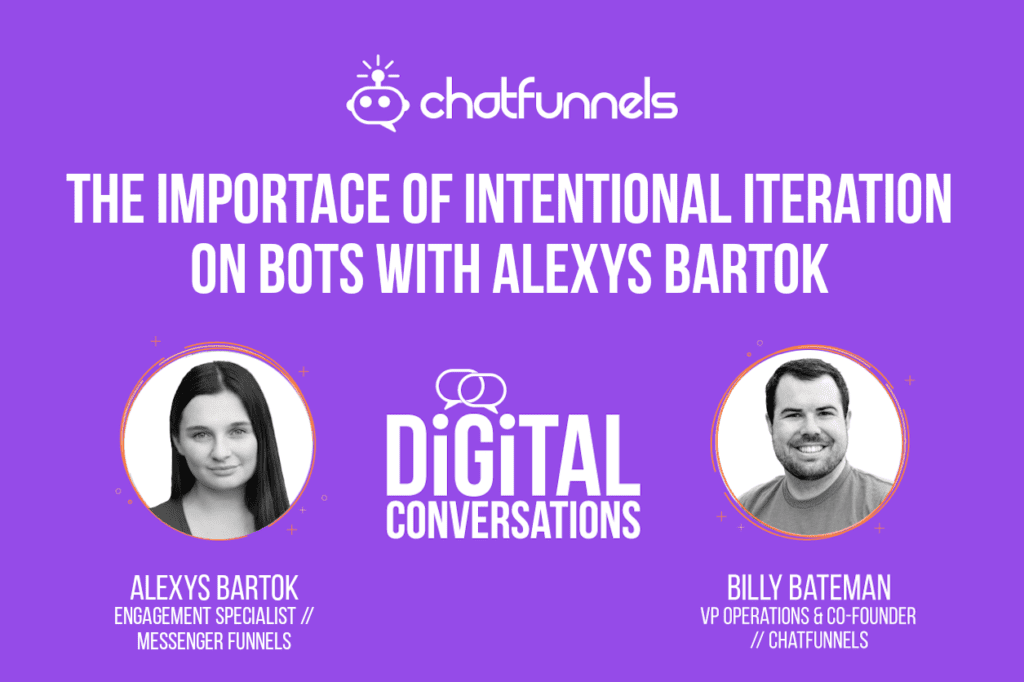
Reading Time: 11 minutes
Overview: In this episode of Digital Conversations with Billy Bateman, we are joined by Alexys Bartok Engagement Specialist at Messenger Funnels. She walks us through the process of designing a highly converting bot. From making a strategic map before you start to creating a persona to intentional iteration once your bot has been launched.
Guest: Alexys Bartok– Alexys started at Messenger Funnels as a Virtual Assistant, and very quickly saw that it needed Chatbot Copywriters, so she asked to learn how to do that. As it happens, Alexys quickly learns a lot of things, and she is currently Sr. Project Manager, and Engagement Specialist at Messenger Funnels. Alexys also is an Actor.
Listening Platforms:
data:image/gif;base64,R0lGODlhAQABAAAAACH5BAEKAAEALAAAAAABAAEAAAICTAEAOw==
Transcription
Billy: Welcome to the show today. Today I have the pleasure of being joined by Alexys Bartok from Messenger funnels. Alexys how are you doing today.
Alexys: I’m good thanks so much for having me on.
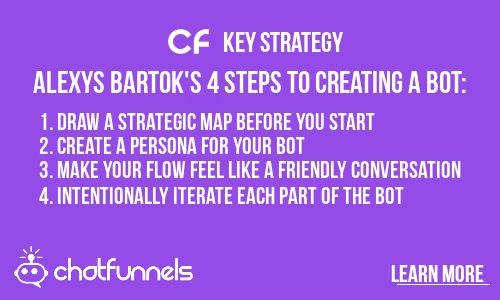
Billy: Yeah, we’re excited to have you on. You are the conversational specialist in chief copywriter for Messenger funnels. We’re going to dive into, how do you build but then how do you make them really good after you’ve got your first iteration. But before we get into that just tell us a little bit about yourself and how you got into bots.
Alexys: Yeah of course it’s been quite a journey. I’ve been doing it for only two years. Which in the grand scheme of life is not very long. Really, I got into it because I was working for Mary Catherine Johnson over at Messenger funnels as a VA. I thought everything she was doing was really interesting and I saw the need for another copy writer. So, I asked hey would you be willing to train me on this and maybe I could work my way up. She was like yes, let’s do it. I was trained on it and overtime just worked up into the project manager space. I think bots are so interesting that anyone in the tech space takes anything they can from them and so it doesn’t take long to learn anything and everything. Now like I said two years later we’re in deep.
Billy: Yeah well, two years is short in life but with bots and marketing it’s actually kind of a long time.
Alexys: It’s true.
Billy: Okay, before we get into bots, if we want to learn who Alexys is and we’re going to look you up on social on your LinkedIn or your Instagram. What’s something we wouldn’t be able to figure out about you?
Alexys: Is this like a businessy question or like a personal?
Billy: Whatever you want.
Alexys: From like a personal side, I really want a dog and a cat, but I don’t feel like I’m ready to make that commitment. So, I have a fern. A plant and she’s doing okay but quite honestly, I don’t take care of her that great. I’m not great at commitment when it comes to taking care of living things.
Billy: Okay awesome. The fern must be resilient if it’s still alive then.
Alexys: It is. Once a week I’m like it’s okay you can do this, and I water her, and she comes back.
Billy: That’s good. Well let’s dive into in bots a little bit. When you first design a bot. You’re in charge of designing these. Walk us through your process from the point where, hey we need a bot that does this too I feel like I have something that’s really good.
Make a Strategic Map
Alexys: Yeah of course the biggest thing that’s usually overlooked is actually doing a strategy mind map. Instead of jumping in and just starting to write the copy or build the flow or whatever your first step usually is. You actually want to sit down and look at, what is happening? What is the end result? What’s the conversion? Maybe it’s for a coach and the goal is the prospect buys and so that is the conversion. You actually want to sit down, and you could do it on Google drawings, Google Slides, a lot of people like Funnelytics, the fancier stuff. Really anything works.
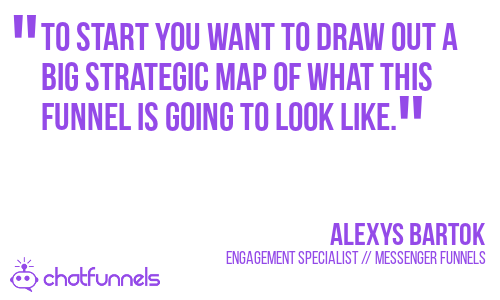
You just want to literally draw out a big strategic map of what this funnel is going to look like. That means you actually start with the end. So if they have to buy then what do they need to get to that, Is it going to be a webinar? Is it going to be a 5 day challenge? Then from there we need to think, how are they going to get to that webinar, the challenge is that going to be nurturing, segmentation. Then how are they going to get to that lead magnets and all of that. Really, you’re working backwards so that way you see its a thorough adventure that’s all aligned with the prospect.
Billy: That makes sense. You’ve got the map. Then when you start writing copy you’re just filling in along that map.
Create a Persona for Your Bot
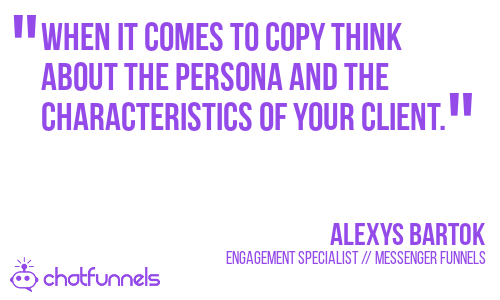
Alexys: So the copy, it’s much more involved than just filling it in. So when it comes to copy you actually really just take a step back and think about the persona and the characteristics of not only your client but the ideal clients for your client.
So really you want to make a persona for your bot because it’s actually illegal in quite a few places for a bot to seem like a human. For instance, at Messenger funnels ours is Mefi that’s just our little icon logo. We had a football, Frank the footy fan was for a football flow. You want to create a persona that’s really going to align with the ideal client.
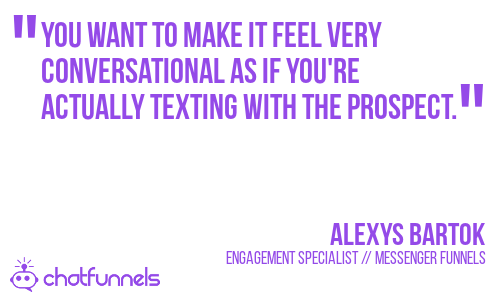
Then you want to make it feel very conversational as if you’re actually texting with the prospect. You do that by asking segmentation questions. Keeping with that same coach who’s selling a program maybe it’s a weight loss program. So, how to lose the last 10 pounds. You want to be asking questions like how what would those last 10 pounds, why do you need that? And of course, it’s a bot so you don’t want to ask open ended questions, you can with custom fields, and you can get fancy. But really, if you come at it from a sales perspective you want to always be showing them the transformation. You’re painting them a picture and you’re giving them the why in their nurturing.
When you’re building the copy you really just thinking of bringing them on this journey. It’s kind of like when you go on a road trip and when you plan out a road trip you plan with the destination 1st and you plan backwards. I actually live in Atlanta and when I moved to Atlanta I drove there from California. Originally, I was like, I just will stay at cheap motels along the way I want to get there as fast as possible but then I was convinced to stay at really cool air B&B’s along way. Which made the whole adventure to get there really fun. You want those little checkpoints to be really fun so that way whether they buy or not they really feel aligned with your brand.
Billy: That does make sense you’ve got your bot persona you’ve got your buyer persona. Let’s build something that can really be enjoyable along the way. And lead them and nudge them in the direction we want to go as marketers. So, if you’ve got a V1 and you’ve got something going do you just set it and forget it? I know you don’t from listening to what you said. Because that’s the temptation it’s, hey we built a bot it seems to work, it’s easy for us like let’s just let it do its thing. Now you I’ve heard you talk about what you call intentional iteration and I really want you to dive into that and explain what’s your process and how you are approaching this.
Intentional Iteration
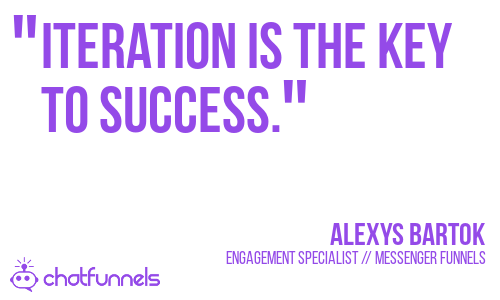
Alexys: Of course, so iteration I think is the key to success. Of course, you want to lay the groundwork and have a very successful plot but a lot of times you just want to get something launched. Progress is better than perfection and so you get it launched and then a lot of times the question, if you’re an agency you get it all the time, what would I pay you for a monthly retainer like why would I do that? Iteration is when you actually go to each and every button in the bot and look at it and you actually make changes.
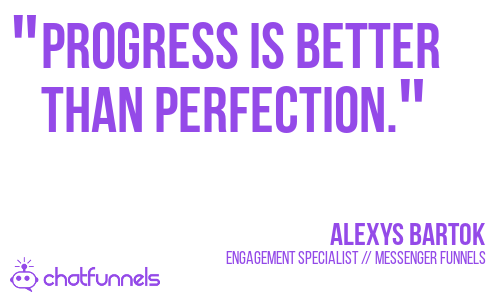
We have a case study on this where we had a client who was a relationship development coach. He had a 30 day free thing, giving a relationship a marriage boost in the bot. In the beginning we were getting three or four sales a week. And he really wanted his copy in the bot, and he was a very dry guy. He was like you know yes, no not really asking a lot of questions. When we came into the iteration phase what we did is you came into every single button and you just changed it and tweaked it a little bit. How you do that is. Do you have a question?
Billy: Yeah so are you doing all of them at once or one at a time? What’s your approach on that?
Alexys: I suggest doing about two to four messages a week. In this 30-day sequence I would do two to four messages a week. You can do more but quite honestly, we have a lot of clients. So, you can do a lot, but you also truly should be split testing things. With this it was a marriage boost kind of challenge if you will, and one time we might just be delivering a PDF but another time we might ask an engaging question before delivering the PDF. It’s changing those, instead of split testing within the flow like you can often do.
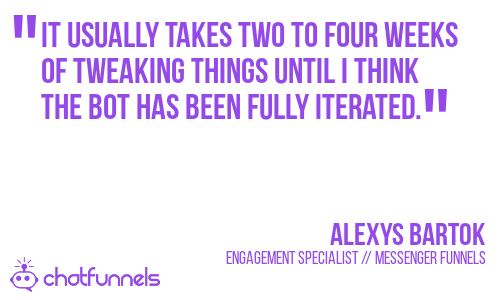
Since it’s already launched it’s iterating those different flows to see which one works better. Like I said you go in and you do that and it’s really important that you take screenshots. You put the stats somewhere, however you want to do it. I take screenshots of everything before I change it. While I’m changing it and it usually takes two to four weeks of tweaking things until I think it has been fully iterated. by doing this with this one client it went from three to four sales a week to 30 to 40 sales a week.
Billy: That’s awesome
Alexys: It actually 10x the sales just by going in and tweaking the questions. Instead of saying you know click below, if you’re interested click below. We change it to: are you ready to get help with your marriage? Then the button would say yes.
Billy: That makes sense. So typically, when you’re doing these iterations, what kind of results are you getting? Is 10 X typical from V1 to kind of final product and they’re never all the way done. So, what do you typically see in your in your boost as you’re testing things?
Alexys: I’d say it’s case by case. This one started out lower because he did really want to use his copy and so we were split testing our copy versus his copy from the beginning. So, you know three to four sales a week is not bad but it’s less than what we wanted to see in the beginning anyway. Like you said it’s never done, truthfully this is the only client we’ve ever had where we got to a point where we iterated everything.
All of our clickthrough rates were over 50%. We were getting over 40 sales a week. And we were like do you want to add something else or I think we’re kind of we’re kind of done here. I don’t have a hard statistic that I would feel comfortable saying but I do know that I can confidently say the bot will definitely increase. The conversions will definitely increase because you shouldn’t just build something and be done. It’s kind of like building a house and then not living in it.
Billy: For sure, I mean that’s something we do a lot with our clients. Is, hey we’re going to run experiments for you and we’re going to test the question order. The options like you’re saying how the bot will ask questions and then we do a lot of live chat. And then how are we bringing agents in to do live chat? When are we bringing them in? Not everything works but if you’re consistent with it you always get better.
Alexys: So right and that’s also why it’s so important to take the screenshots. Honestly, I took screenshots and I would make a presentation each week. Then I save the presentation each week and then I would go back and look at it. Because sometimes it did go down. Sometimes I would say, they didn’t like that question that was too real, too honest. I need to change it. It’s all about iteration and just making changes.
Billy: So when you’re iterating, if you know somebody’s new like I’m a marketer I built you know a bot on Facebook. Where would you start with the variables? Is it the order of the questions that you’re asking people? Is it the button options? All of the above? But where would you say hey start here when you’re running your tests. Do you have any recommendations?
Where to start
Alexys: Yeah, I would always start with the buttons and the call to actions. When I say the call to actions, I don’t just mean trying to get the purchase or whatever the conversion is. I even just mean like the mini wins along the way of getting them to press the button. So really that’s where the big intentional iterations occur. I don’t always change orders of questions unless I really see hey there’s a big drop-off here. That one might need to be taken out altogether or you know they weren’t ready for that. But really the best place to start is just seeing, can this call to action be more alluring. Can this button have an emoji? Does that align with what we talked about in the copy, does that align with the persona in the client’s perspective?
Billy: Well before I let you go Alexys, what is 1 tip for anybody getting into using bots? What is your tip for him if you’re going to say start here and just do one thing?
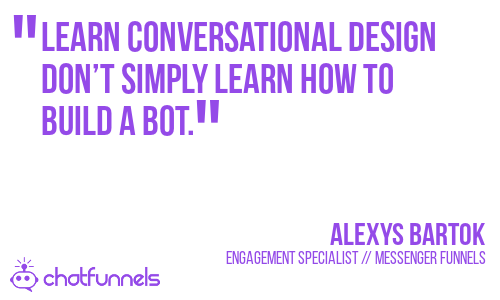
Alexys: That is a loaded question. I would say the biggest thing to learn to start with doing is learning conversational design. Not simply learning how to build a bot. You can waste a lot of time really getting deep into the tech and how you can do amazing fancy things with tech that honestly, I can’t even do. But where you can make a lot of money and make a really big difference is just conversational marketing and design.
Billy: Awesome and do you have any recommendations on where people can go to learn conversational design.
Alexys: Over at Messenger funnels we have a lot of stuff about that. Bot Academy that’s really a big thing that we’re focusing on at bot Academy is coaching on that as well.
Billy: Awesome. Thank you, Alexys, and if people want to get a hold of you and continue the conversation where can they get a hold of you?
Alexys: You can reach out if you go over to the Messenger Funnels page there should be an option, you can just message the bot. Say, hey Alexys I heard you on the podcast and I’d love to talk. That’s probably the best way. I’m always in the bot.
Billy: Alright you heard it here so thank you and we’ll chat later.
Alexys: Awesome thanks so much for having me!
